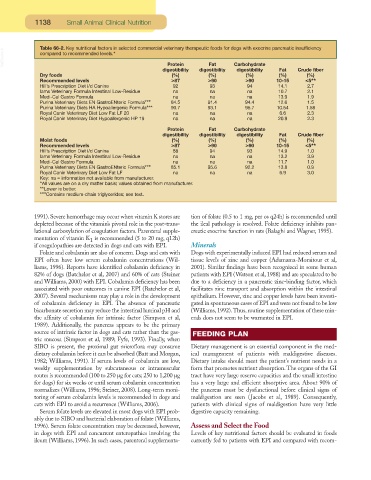Page 1093 - Small Animal Clinical Nutrition 5th Edition
P. 1093
1138 Small Animal Clinical Nutrition
VetBooks.ir Table 66-2. Key nutritional factors in selected commercial veterinary therapeutic foods for dogs with exocrine pancreatic insufficiency
compared to recommended levels.*
Fat
Protein
digestibility
digestibility digestibility Carbohydrate Fat Crude fiber
Dry foods (%) (%) (%) (%) (%)
Recommended levels ≥87 ≥90 ≥90 10-15 ≤5**
Hill’s Prescription Diet i/d Canine 92 93 94 14.1 2.7
Iams Veterinary Formula Intestinal Low-Residue na na na 10.7 2.1
Medi-Cal Gastro Formula na na na 13.9 1.9
Purina Veterinary Diets EN GastroENteric Formula*** 84.5 91.4 94.4 12.6 1.5
Purina Veterinary Diets HA Hypoallergenic Formula*** 90.7 93.1 95.7 10.54 1.58
Royal Canin Veterinary Diet Low Fat LF 20 na na na 6.6 2.3
Royal Canin Veterinary Diet Hypoallergenic HP 19 na na na 20.9 2.3
Protein Fat Carbohydrate
digestibility digestibility digestibility Fat Crude fiber
Moist foods (%) (%) (%) (%) (%)
Recommended levels ≥87 ≥90 ≥90 10-15 ≤5**
Hill’s Prescription Diet i/d Canine 88 94 93 14.9 1.0
Iams Veterinary Formula Intestinal Low-Residue na na na 13.2 3.9
Medi-Cal Gastro Formula na na na 11.7 1.0
Purina Veterinary Diets EN GastroENteric Formula*** 85.1 95.6 92.2 13.8 0.9
Royal Canin Veterinary Diet Low Fat LF na na na 6.9 3.0
Key: na = information not available from manufacturer.
*All values are on a dry matter basis; values obtained from manufacturer.
**Lower is better.
***Contains medium-chain triglycerides; see text.
1991).Severe hemorrhage may occur when vitamin K stores are tion of folate (0.5 to 1 mg, per os q24h) is recommended until
depleted because of the vitamin’s pivotal role in the post-trans- the ileal pathology is resolved. Folate deficiency inhibits pan-
lational carboxylation of coagulation factors. Parenteral supple- creatic exocrine function in rats (Balaghi and Wagner, 1995).
mentation of vitamin K is recommended (5 to 20 mg, q12h)
1
if coagulopathies are detected in dogs and cats with EPI. Minerals
Folate and cobalamin are also of concern. Dogs and cats with Dogs with experimentally induced EPI had reduced serum and
EPI often have low serum cobalamin concentrations (Wil- tissue levels of zinc and copper (Adamama-Moraitour et al,
liams, 1996). Reports have identified cobalamin deficiency in 2001). Similar findings have been recognized in some human
82% of dogs (Batchelor et al, 2007) and 60% of cats (Steiner patients with EPI (Watson et al, 1988) and are speculated to be
and Williams, 2000) with EPI. Cobalamin deficiency has been due to a deficiency in a pancreatic zinc-binding factor, which
associated with poor outcomes in canine EPI (Batchelor et al, facilitates zinc transport and absorption within the intestinal
2007). Several mechanisms may play a role in the development epithelium. However, zinc and copper levels have been investi-
of cobalamin deficiency in EPI. The absence of pancreatic gated in spontaneous cases of EPI and were not found to be low
bicarbonate secretion may reduce the intestinal luminal pH and (Williams, 1992).Thus, routine supplementation of these min-
the affinity of cobalamin for intrinsic factor (Simpson et al, erals does not seem to be warranted in EPI.
1989). Additionally, the pancreas appears to be the primary
source of intrinsic factor in dogs and cats rather than the gas- FEEDING PLAN
tric mucosa (Simpson et al, 1989; Fyfe, 1993). Finally, when
SIBO is present, the proximal gut microflora may consume Dietary management is an essential component in the med-
dietary cobalamin before it can be absorbed (Batt and Morgan, ical management of patients with maldigestive diseases.
1982; Williams, 1991). If serum levels of cobalamin are low, Dietary intake should meet the patient’s nutrient needs in a
weekly supplementation by subcutaneous or intramuscular form that promotes nutrient absorption.The organs of the GI
routes is recommended (100 to 250 µg for cats; 250 to 1,200 µg tract have very large reserve capacities and the small intestine
for dogs) for six weeks or until serum cobalamin concentration has a very large and efficient absorptive area. About 90% of
normalizes (Williams, 1996; Steiner, 2008). Long-term moni- the pancreas must be dysfunctional before clinical signs of
toring of serum cobalamin levels is recommended in dogs and maldigestion are seen (Jacobs et al, 1989). Consequently,
cats with EPI to avoid a recurrence (Williams, 2006). patients with clinical signs of maldigestion have very little
Serum folate levels are elevated in most dogs with EPI prob- digestive capacity remaining.
ably due to SIBO and bacterial elaboration of folate (Williams,
1996). Serum folate concentration may be decreased, however, Assess and Select the Food
in dogs with EPI and concurrent enteropathies involving the Levels of key nutritional factors should be evaluated in foods
ileum (Williams, 1996). In such cases, parenteral supplementa- currently fed to patients with EPI and compared with recom-

